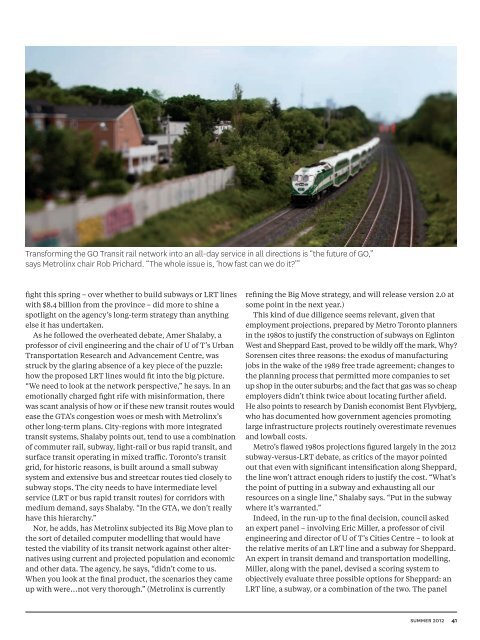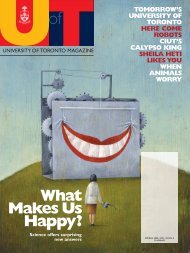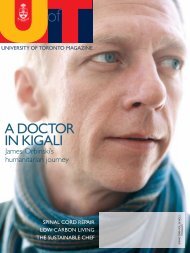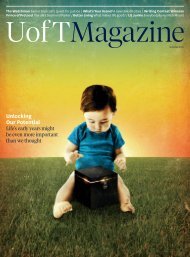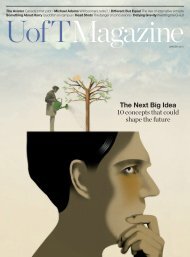What's the solution to Toronto's traffic problems? - University of ...
What's the solution to Toronto's traffic problems? - University of ...
What's the solution to Toronto's traffic problems? - University of ...
You also want an ePaper? Increase the reach of your titles
YUMPU automatically turns print PDFs into web optimized ePapers that Google loves.
Transforming <strong>the</strong> GO Transit rail network in<strong>to</strong> an all-day service in all directions is “<strong>the</strong> future <strong>of</strong> GO,”<br />
says Metrolinx chair Rob Prichard. “The whole issue is, ‘how fast can we do it’”<br />
fight this spring – over whe<strong>the</strong>r <strong>to</strong> build subways or LRT lines<br />
with $8.4 billion from <strong>the</strong> province – did more <strong>to</strong> shine a<br />
spotlight on <strong>the</strong> agency’s long-term strategy than anything<br />
else it has undertaken.<br />
As he followed <strong>the</strong> overheated debate, Amer Shalaby, a<br />
pr<strong>of</strong>essor <strong>of</strong> civil engineering and <strong>the</strong> chair <strong>of</strong> U <strong>of</strong> T’s Urban<br />
Transportation Research and Advancement Centre, was<br />
struck by <strong>the</strong> glaring absence <strong>of</strong> a key piece <strong>of</strong> <strong>the</strong> puzzle:<br />
how <strong>the</strong> proposed LRT lines would fit in<strong>to</strong> <strong>the</strong> big picture.<br />
“We need <strong>to</strong> look at <strong>the</strong> network perspective,” he says. In an<br />
emotionally charged fight rife with misinformation, <strong>the</strong>re<br />
was scant analysis <strong>of</strong> how or if <strong>the</strong>se new transit routes would<br />
ease <strong>the</strong> GTA’s congestion woes or mesh with Metrolinx’s<br />
o<strong>the</strong>r long-term plans. City-regions with more integrated<br />
transit systems, Shalaby points out, tend <strong>to</strong> use a combination<br />
<strong>of</strong> commuter rail, subway, light-rail or bus rapid transit, and<br />
surface transit operating in mixed <strong>traffic</strong>. Toron<strong>to</strong>’s transit<br />
grid, for his<strong>to</strong>ric reasons, is built around a small subway<br />
system and extensive bus and streetcar routes tied closely <strong>to</strong><br />
subway s<strong>to</strong>ps. The city needs <strong>to</strong> have intermediate level<br />
service (LRT or bus rapid transit routes) for corridors with<br />
medium demand, says Shalaby. “In <strong>the</strong> GTA, we don’t really<br />
have this hierarchy.”<br />
Nor, he adds, has Metrolinx subjected its Big Move plan <strong>to</strong><br />
<strong>the</strong> sort <strong>of</strong> detailed computer modelling that would have<br />
tested <strong>the</strong> viability <strong>of</strong> its transit network against o<strong>the</strong>r alternatives<br />
using current and projected population and economic<br />
and o<strong>the</strong>r data. The agency, he says, “didn’t come <strong>to</strong> us.<br />
When you look at <strong>the</strong> final product, <strong>the</strong> scenarios <strong>the</strong>y came<br />
up with were . . . not very thorough.” (Metrolinx is currently<br />
refining <strong>the</strong> Big Move strategy, and will release version 2.0 at<br />
some point in <strong>the</strong> next year.)<br />
This kind <strong>of</strong> due diligence seems relevant, given that<br />
employment projections, prepared by Metro Toron<strong>to</strong> planners<br />
in <strong>the</strong> 1980s <strong>to</strong> justify <strong>the</strong> construction <strong>of</strong> subways on Eglin<strong>to</strong>n<br />
West and Sheppard East, proved <strong>to</strong> be wildly <strong>of</strong>f <strong>the</strong> mark. Why<br />
Sorensen cites three reasons: <strong>the</strong> exodus <strong>of</strong> manufacturing<br />
jobs in <strong>the</strong> wake <strong>of</strong> <strong>the</strong> 1989 free trade agreement; changes <strong>to</strong><br />
<strong>the</strong> planning process that permitted more companies <strong>to</strong> set<br />
up shop in <strong>the</strong> outer suburbs; and <strong>the</strong> fact that gas was so cheap<br />
employers didn’t think twice about locating fur<strong>the</strong>r afield.<br />
He also points <strong>to</strong> research by Danish economist Bent Flyvbjerg,<br />
who has documented how government agencies promoting<br />
large infrastructure projects routinely overestimate revenues<br />
and lowball costs.<br />
Metro’s flawed 1980s projections figured largely in <strong>the</strong> 2012<br />
subway-versus-LRT debate, as critics <strong>of</strong> <strong>the</strong> mayor pointed<br />
out that even with significant intensification along Sheppard,<br />
<strong>the</strong> line won’t attract enough riders <strong>to</strong> justify <strong>the</strong> cost. “What’s<br />
<strong>the</strong> point <strong>of</strong> putting in a subway and exhausting all our<br />
resources on a single line,” Shalaby says. “Put in <strong>the</strong> subway<br />
where it’s warranted.”<br />
Indeed, in <strong>the</strong> run-up <strong>to</strong> <strong>the</strong> final decision, council asked<br />
an expert panel – involving Eric Miller, a pr<strong>of</strong>essor <strong>of</strong> civil<br />
engineering and direc<strong>to</strong>r <strong>of</strong> U <strong>of</strong> T’s Cities Centre – <strong>to</strong> look at<br />
<strong>the</strong> relative merits <strong>of</strong> an LRT line and a subway for Sheppard.<br />
An expert in transit demand and transportation modelling,<br />
Miller, along with <strong>the</strong> panel, devised a scoring system <strong>to</strong><br />
objectively evaluate three possible options for Sheppard: an<br />
LRT line, a subway, or a combination <strong>of</strong> <strong>the</strong> two. The panel<br />
summer 2012 41


